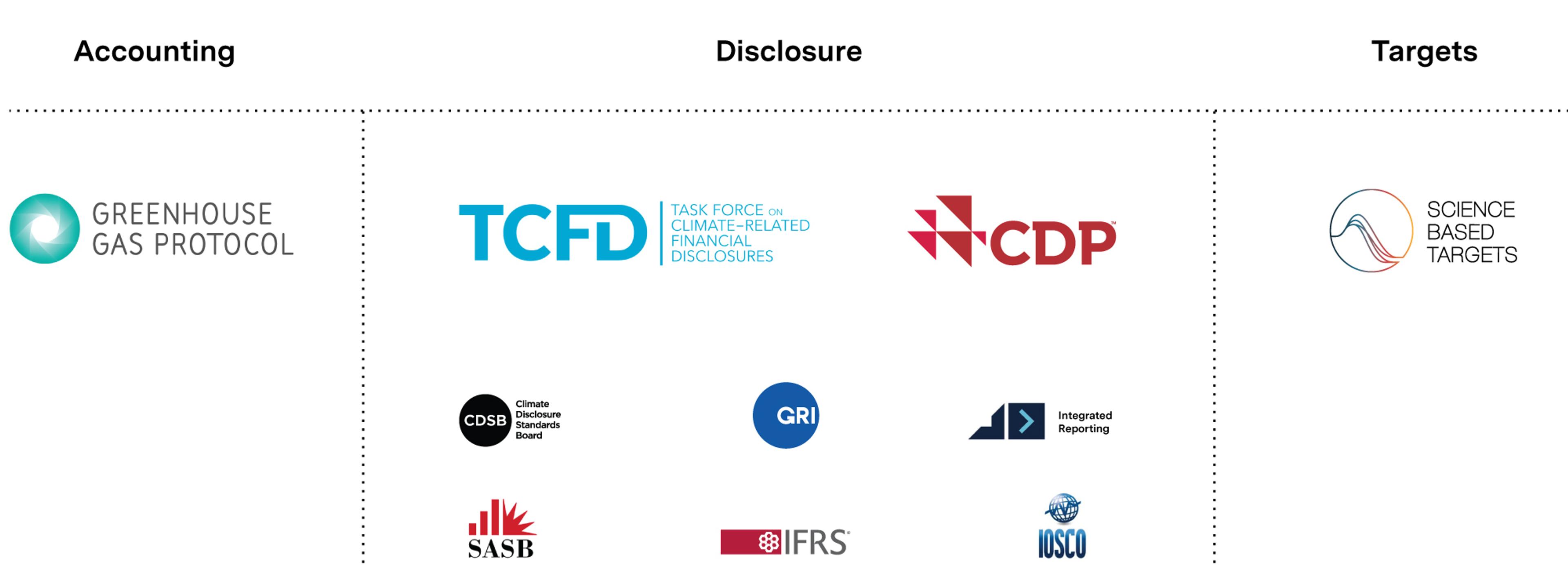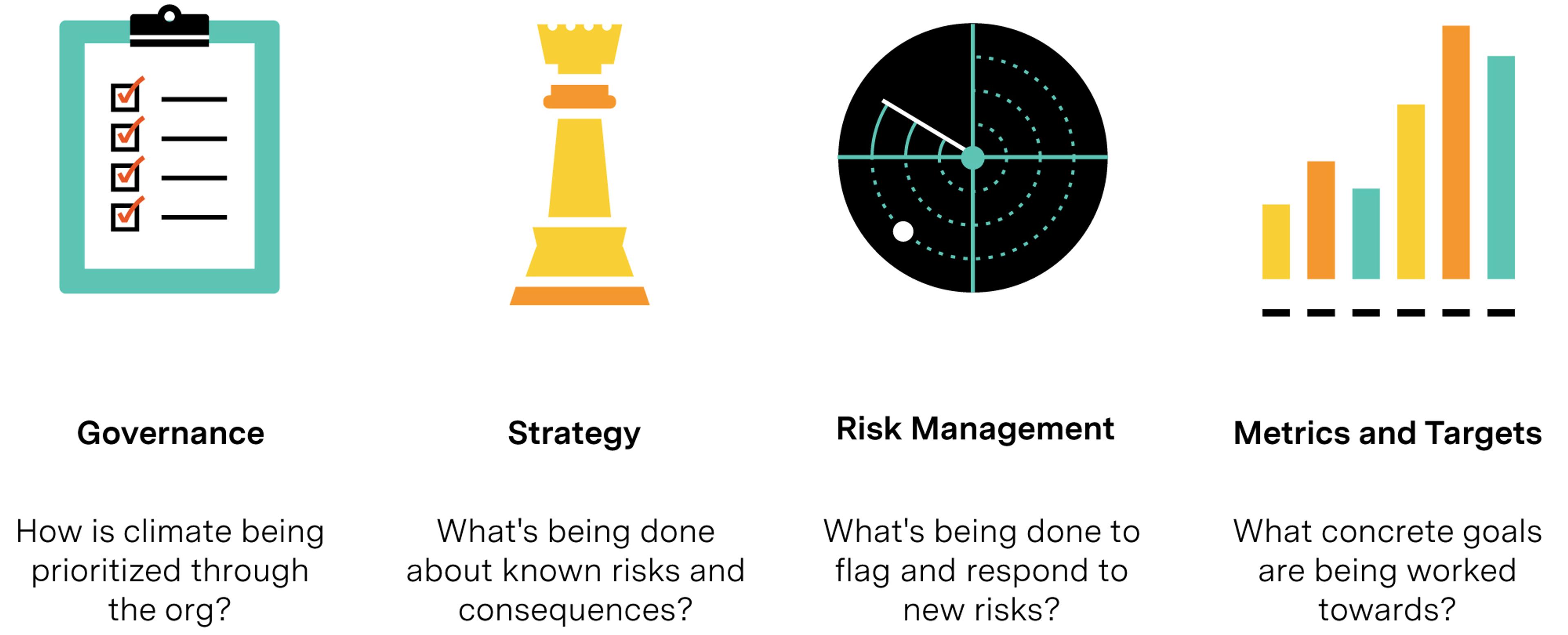We’re in a new climate era. Companies and CFOs are now expected to report their carbon emissions with the same rigour they bring to their financial results.
To promote consistency, the Financial Stability Board—a UN-style body for global financial policy—created the Task Force on Climate-related Financial Disclosures (TCFD), which in 2017 released their first draft of what's now known as the ‘TCFD framework.’ With the transition to the ISSB standard still a few years away, the TCFD framework continues to be the global baseline for climate reporting today.
Regulators are paying attention to these disclosures: in the UK, TCFD-style disclosures are required for premium and standard listed companies, and the Financial Conduct Authority (FCA) are reviewing these in detail. In this guide, we explain what companies need to know about TCFD disclosure standards. Watershed helps companies navigate all of this reporting; reach out if we can help.
The scaffolding of climate governance
The last few years have seen an initial explosion of frameworks narrowed down to a clear set of high-impact standards across three categories:

How should companies count emissions? Virtually all accounting now follows the Greenhouse Gas Protocol’s standards, which have become to carbon accounting what GAAP is to traditional finance: their rules make it clear what needs to be counted and which buckets to put which items in.
What information should companies share publicly? Most global disclosures are now built atop TCFD, which asks companies 11 core questions about their emissions and climate planning.
TCFD is the recognised global standard
TCFD standards have been adopted by the G7 along with a coalition of corporations worth over $25 trillion. They also form the basis of much of the new climate disclosure regulation around the globe, including the UK and EU. This is great news for companies: there’s now a common language for reporting on carbon, just as there is for financial reporting.
Separately in 2023, the International Sustainability Standards Board (ISSB) released their first set of standards, which are widely acknowledged to be a new global reporting baseline for climate. Many countries across the G20 are in the process of adopting the ISSB standards, with Hong Kong, Singapore, etc all publicly commiting to integrate the ISSB standards into regulations in the coming years.
The ISSB standards draw directly from the TCFD framework, and therefore the work companies do in preparing TCFD responses will largely be reusable across the board.
What are the TCFD Reporting Requirements?
The core of TCFD is a set of four pillars and 11 disclosure questions that test the integration of climate issues within an organisation. Within each pillar is a set of key disclosure questions about emissions and climate strategy.
While all four pillars are important to address, TCFD views the metrics and targets pillar as the “connective tissue” between all the other pillars. Measuring GHG emissions is at the heart of the metrics and targets pillar, and the Task Force believes that disclosure of GHG emissions is critical to understanding an organisation’s exposure to climate-related risks and opportunities. Ensuring accurate data and transparent methodology is crucial to a successful disclosure.

Governance
- Does your disclosure describe board-level oversight over climate?
- What about management-level oversight?
The point here: how is climate being prioritised and what are the processes in place to effectively manage this? What is leadership doing concretely to incorporate climate into business strategy, and how is management reporting performance back to leadership? Where does climate sit in your org chart? Who owns it? How empowered are they?
Strategy
- Does your disclosure describe your climate-related risks?
- What about the likely impacts of those risks?
- What about expected resilience in likely climate scenarios?
Climate change is well enough understood now for many implications to be obvious. TCFD specifically hones in on climate-related risks and opportunities. What are you doing about them? Are you prepared? Have increased compliance and insurance costs been budgeted for. and are climate-related issues tied to your financial planning? What about climate-related opportunities: how are you quantifying the potential opportunities, and how are these prioritised in your strategy?
Risk management
- Does your disclosure describe how you identify and assess new climate risks?
- What about processes for managing those risks?
- Are those processes integrated into your normal risk management structures?
Who’s on the watchtower? How are these risk management strategies incorporated into the business strategy covered in the previous disclosure? How are you quantifying the impact of these risks on the business? Which risks have been identified as material, and if not, why are they not material?
Metrics and targets
- Does your disclosure describe the metrics you use to assess climate risks?
- Does it list out all your current emissions?
- What about your climate targets?
While TCFD requires disclosure of all Scope 1 and Scope 2 emissions, they also encourage including Scope 3—covering the rest of the value chain—where these emissions are “material”, as Scope 3 is increasingly understood as crucial for understanding exposure to climate-related risks.
Beyond emissions, what concrete goals are being worked towards? Which methodologies and calculations are being used? Where targets have been set, what are the associated time frames and interim targets?
How to write your answers for the TCFD Reporting?
Good disclosures don’t just tick a box: they shed useful light.
TCFD thus asks that all answers be written to be relevant, specific, complete, clear, balanced, consistent, comparable, reliable, verifiable, and objective. Best in class disclosures weave climate deeply into business strategy, leveraging quantifiable metrics to effectively prioritise climate-related risks and opportunities.
How and where do I disclose my TCFD Report?
TCFD is itself neutral on where reporting should be published, as those requirements tend to be set by local regulators. The default best practice is for companies to include their answers in their annual financial report and publish them on their website.
The UK requires that all listed companies disclose a TCFD-style report—in addition to their SECR submission!—as part of their annual reporting process. This is typically done via their annual strategic report or directors’ report.
Why should I start the TCFD Reporting?
While originally voluntary, several major economies are now mandating TCFD for their largest companies and institutions: the UK’s “comply or explain'' policy for premium and standard listed firms is already in force, and New Zealand’s similar policy begins applying in 2023.
This is just the start: climate driven disclosures will become the norm as we get deeper into this critical decade. The days of emissions going unreported are effectively over.
Watershed helps listed companies build world class climate programmes and report on their progress thoroughly, and with precision. If we can help you on your journey, get in touch.












